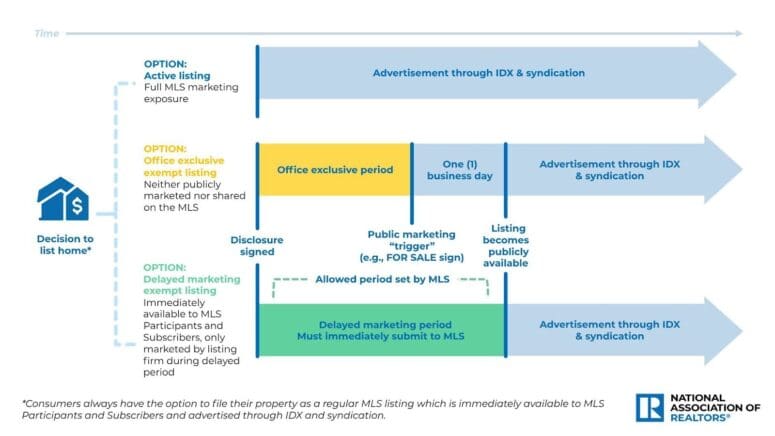New MLS Policy Provides Privacy Options for Sellers

Learn how the National Association of Realtors' new Multiple Listing Options for Sellers policy gives more privacy and control when selling your home.
If you’re planning to sell your home soon, a new policy from the National Association of Realtors (NAR) could give you more control over how your listing is shared, who sees it, and when.
The recently announced Multiple Listing Options for Sellers policy works alongside NAR’s existing Clear Cooperation Policy (CCP) to offer sellers more marketing choices — including greater privacy during the early stages of selling a home.
“NAR continually evaluates its MLS policies to ensure they best serve our members and their consumers while also mitigating and avoiding potential legal risks,” said NAR President Kevin Sears in a public statement. “We are pleased to have found a solution that reflects the best and balanced interests of the industry.”
In this guide, we’ll break down what the new listing policy means for sellers, how it could affect buyers, and what you need to know if you choose to employ this more private marketing option. We’ll also share insights on why encouraging private listings is causing a stir in the industry.
What is the ‘Multiple Listing Options for Sellers’ policy?
The Multiple Listing Options for Sellers policy is a new rule designed to give home sellers more control over when and how their listings are shared online. It adds a new category of exempt listings called a “delayed marketing exempt listing” to the marketing options sellers already have under existing NAR policies.
Here’s how it works:
- Delayed marketing exempt listings allow sellers to delay the public advertising of their home through Internet Data Exchange (IDX) feeds and syndication to third-party websites like Realtor.com, Zillow, and Homes.com.
- While the listing must still be submitted to the MLS and visible to other MLS participants and subscribers, broad public advertising is held back for a set period of time.
- Each MLS can decide how long the delayed marketing period lasts in its local market. NAR encourages MLSs to work with agents and brokers to determine the appropriate timeframe before the September 30, 2025, implementation deadline.
- Sellers who choose this option must sign a disclosure form acknowledging that they understand the benefits they are waiving by delaying full public marketing.
This new policy is meant to give sellers more flexibility while maintaining transparency and cooperation among real estate professionals. As NAR explains, the new approach “preserves CCP while enabling a new marketing choice for sellers and their agents.”
Here’s a quick comparison of the seller options under NAR’s policies:
| Option | Privacy level | What it means |
| Full MLS listing | Low | Listing is shared publicly with all agents and consumer websites through IDX and syndication. |
| Office exclusive exempt listing | Higher | Listing is kept private within the agent’s brokerage and not publicly marketed. |
| Delayed marketing exempt listing | Moderate to high | Listing is visible to MLS participants but not advertised publicly through IDX or syndication for a set period of time. |
“Our goal is and always has been to foster an efficient, fair and transparent real estate market for consumers and to help brokers and agents carry out their ethical duty to put their clients’ interests first,” NAR said in a press release.
What does the new listing policy mean for sellers?
For sellers, the new Multiple Listing Options for Sellers policy offers more ways to customize how your home is marketed — especially if you value privacy or want to strategically time your sale process.
Before this change, most sellers had just two clear options: either list publicly on the MLS immediately or keep the listing private through an office exclusive, often referred to as a “Pocket Listing” or “Secret Listing.” Now, with the addition of delayed marketing exempt listings, you have a middle-ground choice that gives you more control over how and when your home appears on consumer websites.
Here’s what each option could mean for you:
- Full active MLS listing: Your home is listed publicly through the MLS, displayed on agent websites, public listing portals like Realtor.com, Zillow, and Homes.com, and promoted widely. This option usually gives you the most exposure and potential buyer interest right away, but very little privacy.
- Office exclusive exempt listing: Your home is marketed privately within your agent’s brokerage without public advertising. This path might appeal to sellers who want to keep their sale discreet for personal, security, or business reasons. While this is typically an off-MLS approach, your agent may still need to submit your listing to the MLS for documentation purposes, but it will not be shared with other agents or made publicly visible.
- Delayed marketing exempt listing: Your home is entered into the MLS but held back from public advertising (such as IDX feeds and third-party websites) for a set period. You and your agent can still market the property during this time through private channels like a brokerage website, direct emails, yard signs, or word of mouth. Once the delayed period ends, your listing can then move to full public marketing if you choose.

